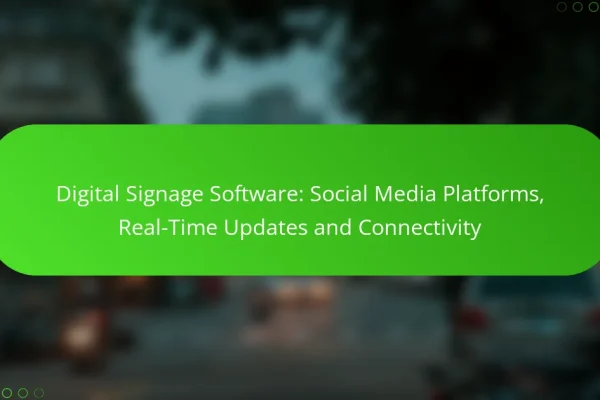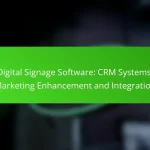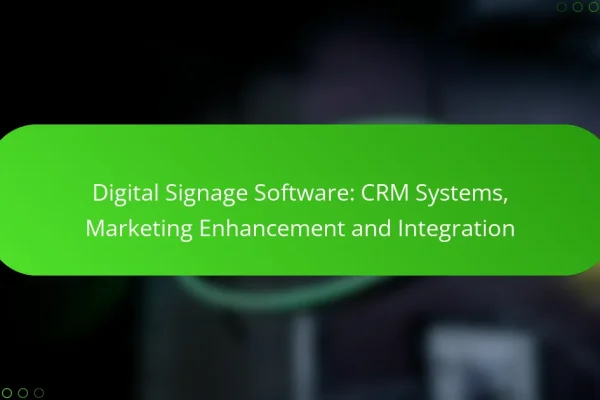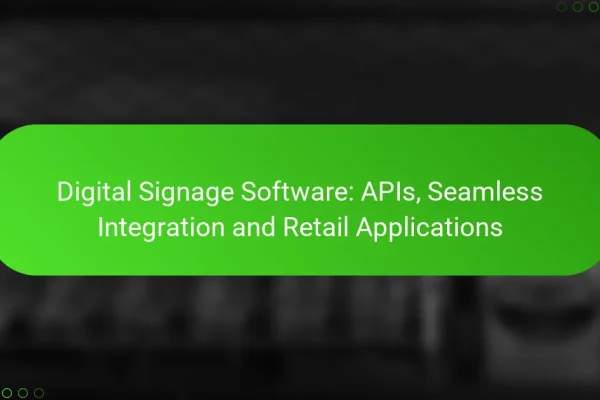What are the best digital signage software solutions in India?
Some of the best digital signage software solutions in India include Scala, BrightSign, ScreenCloud, Yodeck, and Samsung MagicINFO. These platforms offer various features tailored to meet the needs of businesses looking to enhance their visual communication.
Scala
Scala is a robust digital signage software known for its flexibility and scalability. It allows users to create, manage, and distribute content across multiple screens seamlessly, making it suitable for both small businesses and large enterprises.
Its advanced features include real-time data integration, interactive content capabilities, and a user-friendly interface. Scala is particularly beneficial for organizations that require customized solutions to fit their specific branding and operational needs.
BrightSign
BrightSign offers a range of digital signage solutions that combine hardware and software for a complete package. Its players are designed for reliability and performance, making them ideal for high-traffic environments.
With BrightSign, users can manage content remotely and utilize various media formats. The platform supports interactive content and is compatible with numerous third-party applications, enhancing its versatility for different industries.
ScreenCloud
ScreenCloud is a cloud-based digital signage software that simplifies content management across multiple locations. It is particularly user-friendly, allowing non-technical users to create and schedule content easily.
This platform supports a wide range of media types, including images, videos, and social media feeds. ScreenCloud is ideal for businesses that want a straightforward solution without extensive technical requirements.
Yodeck
Yodeck is a cost-effective digital signage solution that focuses on ease of use and quick deployment. It offers a drag-and-drop interface for content creation, making it accessible for users with varying levels of technical expertise.
Yodeck supports various content types and provides features such as remote management and scheduling. It is particularly suited for small to medium-sized businesses looking for an affordable yet powerful signage option.
Samsung MagicINFO
Samsung MagicINFO is a comprehensive digital signage solution that integrates well with Samsung displays. It offers powerful content management capabilities and supports various media formats, making it suitable for diverse applications.
This software is particularly beneficial for businesses that already use Samsung hardware, as it allows for seamless integration and optimized performance. MagicINFO also includes features for remote management and real-time content updates, enhancing operational efficiency.
How does digital signage software integrate with social media?
Digital signage software integrates with social media by allowing users to display real-time updates and content from various platforms directly on screens. This capability enhances engagement and keeps audiences informed with the latest information or promotions.
Real-time content updates
Real-time content updates enable digital signage to reflect the most current information from social media channels. This feature is crucial for businesses that want to share timely promotions, events, or news. For instance, a restaurant can instantly display a new menu item or a limited-time offer as soon as it is posted on their social media account.
To implement real-time updates, ensure that your digital signage software supports API connections to social media platforms. Regularly check for compatibility with popular networks like Facebook, Twitter, and Instagram to maximize your outreach.
Social media feeds display
Displaying social media feeds on digital signage allows for a dynamic presentation of user-generated content and company posts. This can include tweets, Instagram photos, or Facebook updates, creating a vibrant and interactive experience for viewers. For example, a retail store might showcase customer photos using their products, fostering community engagement.
When setting up social media feeds, consider the layout and frequency of updates to maintain viewer interest. Use moderation tools to filter content and ensure that only appropriate posts are displayed, which helps maintain your brand’s image and messaging consistency.
What are the key features for integration with CRM tools?
Key features for integrating digital signage software with CRM tools include data synchronization and customer engagement tracking. These functionalities enhance the effectiveness of marketing campaigns and improve customer interactions by ensuring that information is current and relevant.
Data synchronization
Data synchronization allows digital signage software to automatically update content based on the latest information from CRM systems. This ensures that promotional messages, customer data, and inventory levels are always accurate and reflect real-time changes.
For effective data synchronization, consider using APIs that facilitate seamless communication between your digital signage and CRM platforms. Regular updates, ideally occurring every few minutes, can help maintain consistency and relevance in your displays.
Customer engagement tracking
Customer engagement tracking enables businesses to analyze how viewers interact with digital signage content. By integrating with CRM tools, companies can gather insights on customer behavior, preferences, and responses to specific campaigns.
To implement effective engagement tracking, utilize analytics tools that can measure metrics such as viewer dwell time, interaction rates, and conversion statistics. This data can help refine marketing strategies and tailor content to better meet customer needs, ultimately enhancing the overall customer experience.
How can digital signage software connect with IoT devices?
Digital signage software can connect with IoT devices by utilizing APIs and protocols that facilitate data exchange and control. This integration allows for real-time updates and interactions between digital displays and smart devices, enhancing user engagement and operational efficiency.
Smart device compatibility
Smart device compatibility is crucial for effective digital signage integration. Many digital signage solutions support various IoT devices, including sensors, cameras, and smart displays, enabling seamless communication. For instance, a digital signage system can display tailored content based on data received from environmental sensors, such as temperature or foot traffic.
When selecting digital signage software, ensure it supports widely used protocols like MQTT or HTTP, which facilitate communication with smart devices. This compatibility ensures that your signage can adapt to different environments and user needs.
Automated content delivery
Automated content delivery allows digital signage software to push updates and changes without manual intervention. This feature is particularly beneficial for businesses that need to display timely information, such as promotions or alerts, based on real-time data from IoT devices.
For example, a retail store can automate the display of promotional content based on inventory levels or customer engagement metrics. By setting up rules within the digital signage software, businesses can ensure that the right content is shown at the right time, improving customer experience and operational efficiency.
What are the benefits of integrating digital signage with analytics tools?
Integrating digital signage with analytics tools provides valuable insights into audience engagement and content effectiveness. This combination allows businesses to make data-driven decisions, optimizing their messaging and improving overall performance.
Enhanced audience insights
Integrating analytics tools with digital signage enhances audience insights by providing detailed data on viewer demographics and behavior. Businesses can track who is engaging with their content, including age, gender, and viewing duration, allowing for more targeted messaging.
This data can be collected through various methods, such as facial recognition technology or mobile device tracking. For example, a retail store might use this information to tailor promotions based on the demographics of customers currently in the store, increasing the likelihood of conversion.
Performance tracking
Performance tracking is crucial for assessing the effectiveness of digital signage campaigns. By integrating analytics tools, businesses can monitor key metrics such as viewer engagement rates, content interaction, and conversion rates.
Regularly reviewing this data helps identify which content resonates best with the audience. For instance, a restaurant could analyze which menu items generate the most interest when displayed on digital screens, allowing them to adjust their offerings or marketing strategies accordingly. To maximize effectiveness, businesses should set clear performance goals and review analytics regularly to adapt their strategies.
What criteria should be considered when selecting digital signage software?
When selecting digital signage software, consider integration capabilities, user interface, and scalability. These factors will ensure that the software meets your specific needs and can grow with your organization.
Integration capabilities
Integration capabilities refer to how well the digital signage software can connect with other tools and platforms, such as content management systems, social media, and analytics tools. Look for software that supports APIs or has built-in integrations with popular applications to streamline your workflow.
For example, if you use a specific content management system, ensure the digital signage software can easily pull content from it. This will save time and reduce the need for manual updates.
User interface
The user interface (UI) of digital signage software should be intuitive and user-friendly. A well-designed UI allows users to create, manage, and update content without extensive training or technical knowledge.
Consider software that offers drag-and-drop functionality and customizable templates. This can significantly enhance the user experience and speed up the content creation process.
Scalability
Scalability is crucial for businesses that anticipate growth or changes in their digital signage needs. Choose software that can easily expand to accommodate additional screens or locations without requiring a complete overhaul.
Look for solutions that offer tiered pricing or modular features, allowing you to add capabilities as needed. This flexibility can help you manage costs effectively while ensuring your digital signage remains effective as your business evolves.
How does digital signage software enhance customer experience in retail?
Digital signage software significantly enhances the customer experience in retail by delivering dynamic, engaging content that captures attention and informs shoppers. It allows retailers to showcase promotions, product information, and brand messaging in real-time, creating a more interactive shopping environment.
Improved Communication
Digital signage facilitates better communication between retailers and customers by displaying timely information such as promotions, store hours, and product availability. This immediate access to relevant content helps customers make informed purchasing decisions and enhances their overall shopping experience.
Increased Engagement
Engaging visuals and interactive displays can draw customers into the store and keep them interested. Retailers can use digital signage to showcase videos, animations, or customer testimonials, which can increase dwell time and encourage impulse purchases. For instance, a clothing store might display a video of a fashion show featuring its latest collection.
Personalized Experiences
Digital signage can be tailored to specific customer segments, allowing retailers to deliver personalized content based on demographics or shopping behavior. For example, a grocery store might display health-related promotions to customers in the organic section, enhancing relevance and increasing the likelihood of purchase.
Real-Time Updates
With digital signage, retailers can update content in real-time, ensuring that customers receive the most current information. This is particularly useful for flash sales or limited-time offers, where immediate communication can drive urgency and boost sales. Retailers can change promotions within minutes, adapting to inventory changes or customer trends.
Cost-Effective Marketing
Digital signage can be more cost-effective than traditional print advertising in the long run. While initial setup costs may be higher, the ability to update content without reprinting materials saves money over time. Additionally, digital displays can be used for multiple campaigns, maximizing the return on investment.









